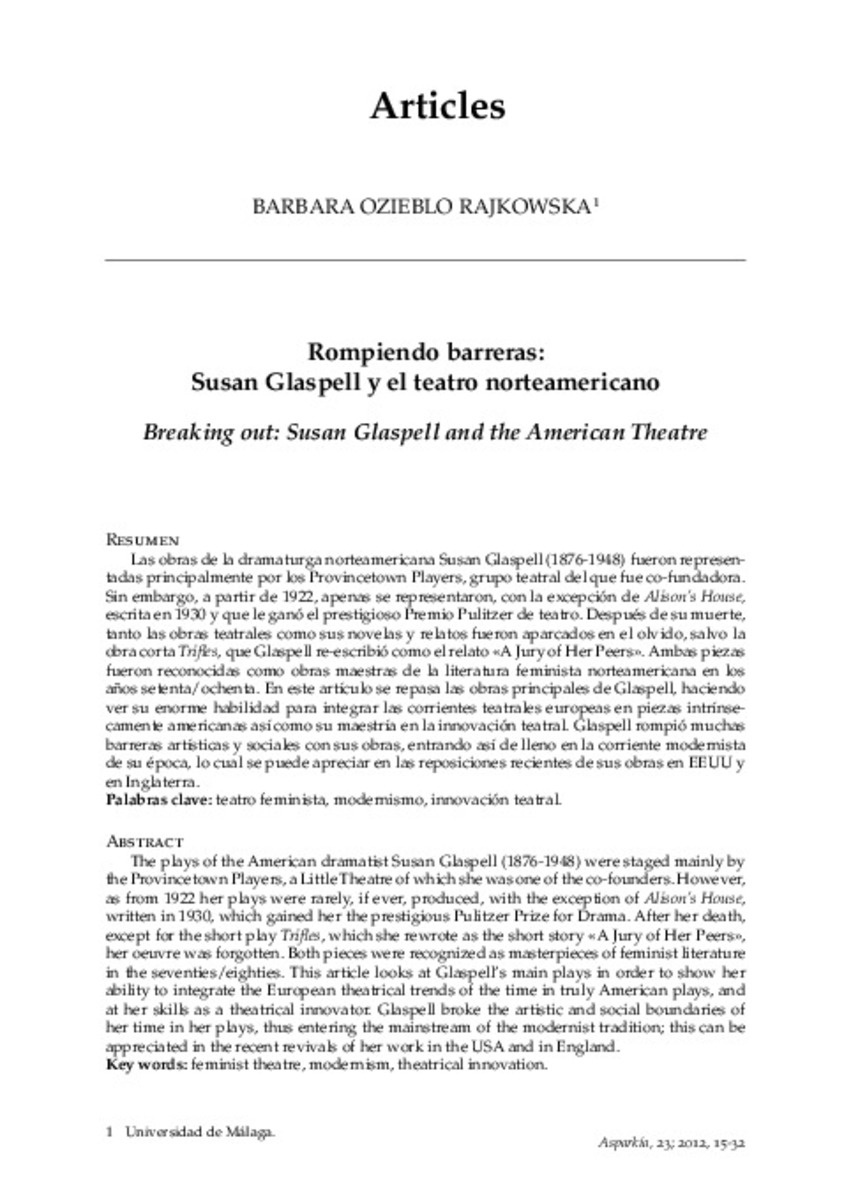Mostrar el registro sencillo del ítem
Rompiendo barreras: Susan Glaspell y el teatro norteamericano
| dc.contributor.author | Ozieblo, Bárbara | |
| dc.date.accessioned | 2015-10-30T11:56:40Z | |
| dc.date.available | 2015-10-30T11:56:40Z | |
| dc.date.issued | 2012 | |
| dc.identifier.issn | 1132-8231 | |
| dc.identifier.issn | 2340-4795 | |
| dc.identifier.uri | http://hdl.handle.net/10234/137805 | |
| dc.description.abstract | Las obras de la dramaturga norteamericana Susan Glaspell (1876-1948) fueron representadas principalmente por los Provincetown Players, grupo teatral del que fue co-fundadora. Sin embargo, a partir de 1922, apenas se representaron, con la excepción de Alison’s House, escrita en 1930 y que le ganó el prestigioso Premio Pulitzer de teatro. Después de su muerte, tanto las obras teatrales como sus novelas y relatos fueron aparcados en el olvido, salvo la obra corta Trifles, que Glaspell re-escribió como el relato «A Jury of Her Peers». Ambas piezas fueron reconocidas como obras maestras de la literatura feminista norteamericana en los años setenta/ochenta. En este artículo se repasa las obras principales de Glaspell, haciendo ver su enorme habilidad para integrar las corrientes teatrales europeas en piezas intrínsecamente americanas así como su maestría en la innovación teatral. Glaspell rompió muchas barreras artísticas y sociales con sus obras, entrando así de lleno en la corriente modernista de su época, lo cual se puede apreciar en las reposiciones recientes de sus obras en EEUU y en Inglaterra. | ca_CA |
| dc.description.abstract | The plays of the American dramatist Susan Glaspell (1876-1948) were staged mainly by the Provincetown Players, a Little Theatre of which she was one of the co-founders. However, as from 1922 her plays were rarely, if ever, produced, with the exception of Alison’s House, written in 1930, which gained her the prestigious Pulitzer Prize for Drama. After her death, except for the short play Trifles, which she rewrote as the short story «A Jury of Her Peers», her oeuvre was forgotten. Both pieces were recognized as masterpieces of feminist literature in the seventies/eighties. This article looks at Glaspell’s main plays in order to show her ability to integrate the European theatrical trends of the time in truly American plays, and at her skills as a theatrical innovator. Glaspell broke the artistic and social boundaries of her time in her plays, thus entering the mainstream of the modernist tradition; this can be appreciated in the recent revivals of her work in the USA and in England. Key words: feminist theatre, modernism, theatrical innovation. | ca_CA |
| dc.format.mimetype | application/pdf | ca_CA |
| dc.language.iso | spa | ca_CA |
| dc.publisher | Publicacions de la Universitat Jaume I | ca_CA |
| dc.relation.isPartOf | Asparkía: investigació feminista. Núm.: 23 | ca_CA |
| dc.rights.uri | http://creativecommons.org/licenses/by-sa/4.0/ | * |
| dc.subject | teatro feminista | ca_CA |
| dc.subject | modernismo | ca_CA |
| dc.subject | innovación teatral | ca_CA |
| dc.subject | feminist theatre | ca_CA |
| dc.subject | modernism | ca_CA |
| dc.subject | theatrical innovation | ca_CA |
| dc.title | Rompiendo barreras: Susan Glaspell y el teatro norteamericano | ca_CA |
| dc.type | info:eu-repo/semantics/article | ca_CA |
| dc.rights.accessRights | info:eu-repo/semantics/openAccess | ca_CA |
| dc.relation.publisherVersion | http://www.e-revistes.uji.es/index.php/asparkia/article/view/568/479 | ca_CA |
Ficheros en el ítem
Este ítem aparece en la(s) siguiente(s) colección(ones)
-
Asparkía_2012_núm.23 [25]








